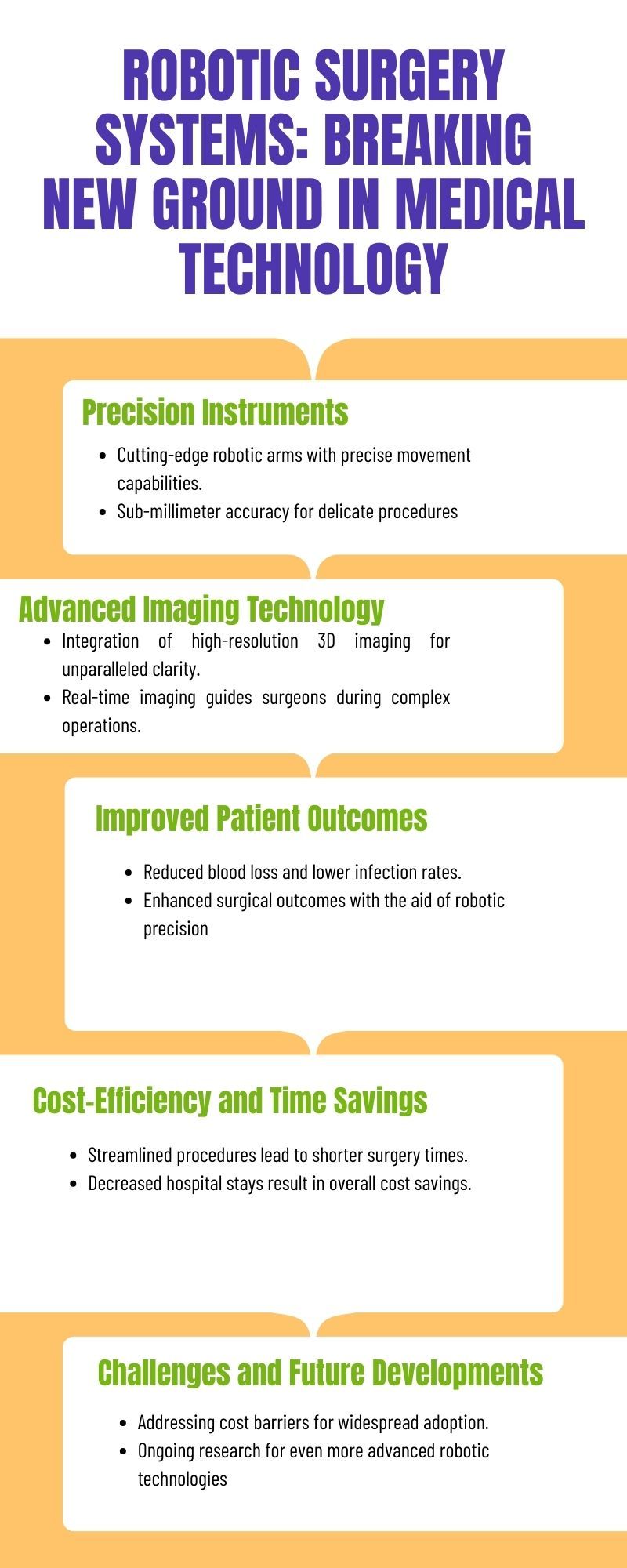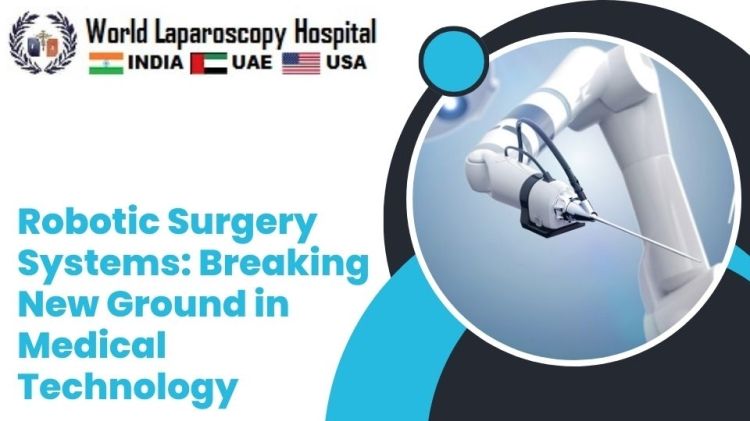Robotic Surgery Systems: Breaking New Ground in Medical Technology
Introduction:
In the ever-evolving landscape of medical technology, robotic surgery systems have emerged as a groundbreaking innovation, transforming the way surgeries are performed and raising the bar for precision and efficiency. As we delve into the realm of robotic-assisted surgery, we witness a fusion of human expertise and advanced robotics, creating a synergy that opens new frontiers in healthcare.

The Evolution of Robotic Surgery:
Historical Context:
The roots of robotic surgery can be traced back to the 1980s when the first attempts were made to introduce automation into surgical procedures. However, it wasn't until the late 20th century that significant strides were made, leading to the development of the da Vinci Surgical System. Introduced in 1999, the da Vinci System became a milestone in robotic surgery, setting the stage for a new era of medical innovation.
The Rise of the da Vinci Surgical System:
The da Vinci Surgical System, developed by Intuitive Surgical, represents a paradigm shift in surgical techniques. This robotic platform allows surgeons to perform minimally invasive surgeries with enhanced precision, control, and a 3D high-definition vision system. The surgeon operates the system from a console, manipulating robotic arms equipped with surgical instruments.
Key Components and Features of Robotic Surgery Systems:
Console and Control System:
One of the central components of robotic surgery systems is the console, where the surgeon sits and controls the robotic arms. The console provides a 3D visualization of the surgical field and allows the surgeon to manipulate the instruments with hand and foot controls. This setup enhances dexterity and minimizes the surgeon's fatigue during prolonged procedures.
Robotic Arms and Instruments:
The robotic arms, an integral part of these systems, are equipped with specialized surgical instruments. These instruments mimic the movements of the surgeon's hands with greater precision, flexibility, and a wider range of motion. This translates into smaller incisions, reduced blood loss, and faster recovery times for patients.
3D Vision System:
The 3D vision system in robotic surgery provides a detailed and immersive view of the operating field. Surgeons can navigate through complex anatomical structures with improved depth perception, enabling them to perform intricate procedures with greater accuracy. This enhanced visualization contributes to the success of surgeries and reduces the risk of complications.
Advantages of Robotic Surgery Systems:
Precision and Accuracy:
One of the primary advantages of robotic surgery systems is the unparalleled precision they offer. The robotic arms eliminate hand tremors and allow for micro-movements, ensuring delicate procedures are performed with meticulous accuracy. This precision contributes to better outcomes, especially in procedures requiring fine suturing or manipulation of intricate structures.
Minimally Invasive Procedures:
Robotic surgery minimizes the invasiveness of procedures, as surgeons can perform surgeries through small incisions. This leads to reduced scarring, less postoperative pain, and faster recovery times for patients. The ability to navigate through tight spaces and access hard-to-reach areas inside the body makes robotic systems particularly valuable in complex surgeries.
Improved Ergonomics for Surgeons:
The ergonomic design of robotic surgery systems addresses the physical strain often associated with traditional open or laparoscopic surgeries. Surgeons can operate comfortably from a seated position at the console, reducing fatigue and the risk of musculoskeletal injuries. This aspect is crucial for the sustainability of surgical careers and contributes to the overall well-being of healthcare professionals.
Applications of Robotic Surgery:
Gynecological Surgery:
Robotic surgery has found significant applications in gynecological procedures, such as hysterectomies and myomectomies. The precision and flexibility offered by robotic systems make them ideal for intricate surgeries in the pelvic region, with benefits including shorter hospital stays and quicker recovery times for patients.
Urological Surgery:
In urology, robotic surgery has become a preferred method for procedures like prostatectomies and nephrectomies. The ability to navigate complex anatomy with precision is crucial in urological surgeries, and robotic systems excel in providing surgeons with the tools needed to achieve optimal outcomes.
Cardiothoracic Surgery:
The use of robotic surgery in cardiothoracic procedures, including coronary artery bypass grafting and mitral valve repair, has gained traction. The dexterity and accuracy of robotic instruments are advantageous in delicate cardiac surgeries, contributing to reduced morbidity and faster rehabilitation for patients.
Challenges and Considerations:
Cost and Accessibility:
While the benefits of robotic surgery are evident, the high initial costs associated with acquiring and maintaining robotic systems pose challenges for healthcare institutions. Additionally, the need for specialized training for surgeons adds to the overall expenses. Ensuring equitable access to this advanced technology remains a critical consideration in the broader adoption of robotic surgery.
Learning Curve for Surgeons:
Robotic surgery requires surgeons to undergo specialized training to master the unique skills needed to operate the robotic system effectively. The learning curve, while surmountable, is a factor that healthcare institutions must consider when integrating robotic surgery into their practices. Ongoing training and skill maintenance are essential for ensuring optimal outcomes.
Future Directions and Innovations:
Artificial Intelligence Integration:
The integration of artificial intelligence (AI) with robotic surgery systems holds immense potential for further enhancing surgical outcomes. AI algorithms can analyze real-time data from the surgical field, providing surgeons with valuable insights and decision support. This synergy between robotics and AI opens doors to increased efficiency and improved patient safety.
Remote and Teleoperated Surgery:
Advancements in communication technologies have paved the way for exploring remote and teleoperated surgery. Surgeons could potentially perform surgeries from different locations, providing expertise to underserved areas or responding to emergencies in real-time. This approach has the potential to revolutionize global access to surgical care.
Conclusion:
Robotic surgery systems have transcended the boundaries of traditional surgical techniques, ushering in a new era of precision, efficiency, and improved patient outcomes. As technology continues to advance, the integration of robotics with artificial intelligence and the exploration of remote surgery open exciting possibilities for the future of healthcare. While challenges such as cost and training persist, the transformative impact of robotic surgery on medical practices is undeniable, shaping the trajectory of surgical innovation and patient care.



